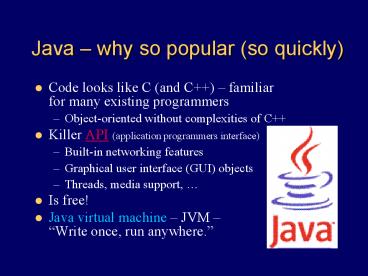Java why so popular so quickly - PowerPoint PPT Presentation
1 / 17
Title:
Java why so popular so quickly
Description:
Java why so popular (so quickly) ... Create file called Hello.java. Compile javac Hello.java (creates bytecode file named Hello.class if successful) ... – PowerPoint PPT presentation
Number of Views:95
Avg rating:3.0/5.0
Title: Java why so popular so quickly
1
Java why so popular (so quickly)
- Code looks like C (and C) familiar for many
existing programmers - Object-oriented without complexities of C
- Killer API (application programmers interface)
- Built-in networking features
- Graphical user interface (GUI) objects
- Threads, media support,
- Is free!
- Java virtual machine JVM Write once,
run anywhere.
2
A simple Java program
- Java programs actually classes (types of
objects) - A first java application class Hello
- Create file called Hello.java
- Compile javac Hello.java (creates
bytecode file named Hello.class if successful) - Execute java Hello
- (invokes JVM)
3
What is a Java application?
- Answer A class with a main method
- e.g., public static void main(String args)
- Huh?
- public can be invoked from another package
- static same for all instances of this class
- void does not return anything
- main the methods name
- (String args) parameter list (an array of
Strings) - block delimiters method definition is
inside
4
Special characters comments
- Escape sequences all start with \
- e.g., \n newline, and \t tab
- Also \ double quotes, and \ single quote
- \\ back slash itself, and more (see text p. 23)
- Play with Hello.java to see effects
- 3 types of comments
- // for single line or end-of-line comment
- / for comment that may
- span lines /
- / Javadoc comment (upcoming topic) /
5
Java has 8 primitive data types
- 7 are number types
- 5 of the number types are integral types
- int most fundamental 4, -123, 9587123 are int
- long for longer integers (2,147,483,647)
- short, byte save space for shorter integers
- char to represent characters A, a, \n
- Other 2 number types are floating point types
- double most fundamental 0.4, -123.3, 95.
- float save space for less precision
- 8th type is boolean to represent true or false
- Every other data type in Java is an object type
6
Objects
- An object is a thing or a concept
- Often a model of a real-world thing or concept
- Probably contains both data and methods i.e., a
software object can know stuff, and do stuff - Easy to create and use (e.g., MoveTester.java)
- Declare reference Rectangle box
- Create the object, and assign it to the reference
- box new Rectangle(5, 10, 20, 30)
- Invoke its methods box.translate(15, 25)
7
Objects vs. object references
- A reference can point to nothing (null).
- It must point to an actual object to be useful.
8
Classes
- Technically, an object is an instance of a class
- Classes define an objects interface
- These are the public methods and data that other
types of objects can access directly - e.g., Rectangles translate() method
- Class definitions also contain the implementation
- The private members and internal details of
methods - e.g., x, y coordinates of Rectangle should be
private data - e.g., how the translate method actually works to
change these coordinates is unimportant to
clients of the class
9
Bank account example
- Software design effort identified the need for
objects that represent bank accounts - Why objects, not just numbers?
- Because bank accounts are more complex
- Need a way to store a balance data
- But also need ways to deposit and withdraw money,
and report the current balance methods - Idea is that other software objects will
- Create new BankAccount objects
- Use the objects methods to solve problems
- But first, must write class BankAccount
10
Class definition I define the interface
- public class BankAccount
- public void deposit(double amount)
- public void withdraw(double amount)
- public double getBalance()
- This is all that programmers of other classes
have to know the public interface - They can start working independently how
methods are implemented doesnt matter - Also the time to document the interface add
javadoc comments - More about javadoc comments later in course
11
Class definition II define the data
- i.e., what objects of this class will know
- Variables declared outside any method
- Includes instance variables
- Can store different values for each instance (see
text fig. 4, p. 39) - May also include static (a.k.a. class)
variables - Tip make instance variables private
- e.g., private double balance
- Other classes cant directly access or alter
- e.g., harrysChecking.balance -1000 // error
12
Class definition III implement the methods
- Often manipulate the data in some way
- public void deposit(double amount)
- balance balance amount
- public void withdraw(double amount)
- balance balance - amount
- Other times provide a copy of the data
- public double getBalance()
- return balance
13
Defining constructors
- A default constructor is always defined
- e.g., new BankAccount() // no parameters
- Initializes instance variables to default values
- Primitive number type values are set to 0
- boolean values are set to false
- Object references are set to null
- Often want to overload the constructor
- e.g., public BankAccount(double initialBalance)
- balance initialBalance
- Name is same as classname, and there is no return
type - See BankAccount.java and BankAccountTester.java
14
Maybe moreMaybe less
15
Variables and memory
- Every variable has
- a name, a type, a size, and a value
- Concept name corresponds to a memory location
- If primitive type actual value stored there
long needs more space than int, and so on - If object type just reference to object stored
there (just need space for memory address) - Actual object is somewhere else
- But reference can be null means no actual object
16
Variables and constants
- Java is strongly-typed
- Must declare type for memory locations used
- e.g., declare 2 doubles, and one String reference
- double a, b
- String s
- Declaring allocates space, but value is undefined
- Must assign value, or compiler wont let you use
it - final variables are constants
- May only assign value once usually when declared
- e.g., final double TAX_RATE 0.0775
17
Identifiers
- Names of classes, variables, methods
- 3 simple rules
- Must consist of a sequence of letters, digits, _,
or - No other characters allowed including no spaces
- Must not begin with a digit
- No Java reserved words allowed
- Unwritten rule Use meaningful names
- Conventions
- NameOfClass begin with uppercase
- other or otherName, unless name of constant, like
PI































